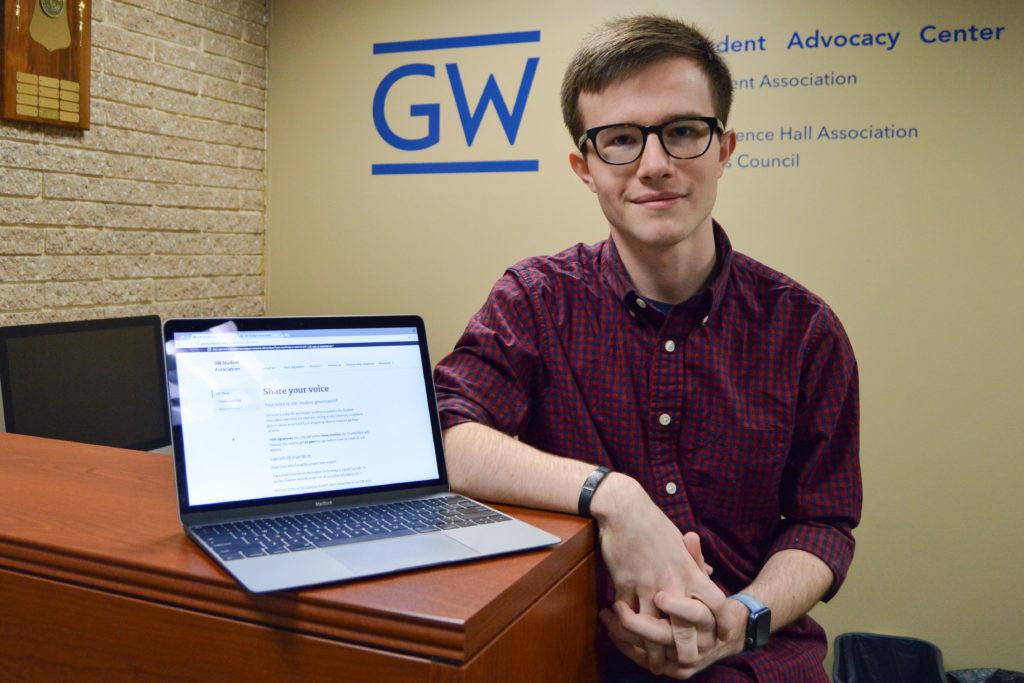Updated: Jan. 22, 2018 at 2:55 a.m.
The Student Association is revamping a year-old platform that allows students to report issues on campus directly to student government.
A new page on the SA’s website will go live Monday, giving students the ability to create and share petitions about GW-specific issues. SA leaders said the platform – called “GW Voice” – will give them the opportunity to work more closely with their constituents and bring students’ most pressing issues to senior administrators.
James Harnett, the SA’s director of information technology, said he began working on the platform over the summer when he redeveloped the SA’s main website. He said last year’s leadership piloted a Reddit-like page on their website, also called “GW Voice,” where students could up- or down-vote ideas posted by other students.
Harnett said he reworked that platform to function more like a Change.org webpage, where any student can log in using their GWID and then create a petition and submit it to the SA for approval. The SA president or a designated representative will be able to weed out any submissions that may not be relevant to GW or include vulgar language, he said.
He said students will then receive an email with a link to their petition, which they can share with friends on social media. Once the petition hits 25 student signatures, it will be posted publicly on the website for any student to sign. At 500 signatures, SA leaders will be required, based on an agreement drafted by leadership, to respond to the post and may bring the petition to administrators, Harnett said.
He said the platform will provide tangible evidence of student support for certain intiatives to bring to leaders like University President Thomas LeBlanc.
“President LeBlanc, he’s talked about this, where you can talk about an idea all day, but if you can bring him proof that this is something that students really, really want, then the chance of that happening will increase exponentially,” he said.
Harnett said petitions should be GW-specific, like support for the installation of a crosswalk on H Street or to reevaluate UPD’s alcohol policies. While the petitions are directed toward the SA president and members of his team, the platform will also allow SA senators to see what students are talking about and supporting, which could inspire legislation, he added.
“That’s kind of the hope – that we can build a tool that makes it easier for people to stay in touch with their constituents,” Harnett said.
Ashley Le, the SA’s vice president for public affairs, said she developed a tutorial video for students to learn how to use the site and will help promote the platform on social media. Le was also involved in the creation of the original GW Voice, which she said wasn’t something the SA “maintained.”
She said the old platform was introduced in September 2016 and was taken down at the end of July with the launch of a new SA website. She said the old platform garnered just 12 suggestions in total, 11 of which were submitted in the fall of 2016, and covered topics like changes to the Vern Express and more academic advocacy in the SA.
Le said many students didn’t know that GW Voice existed last year, which is why the program didn’t receive many suggestions.
“As we relaunch the new platform, our main goal is to make sure that GW Voice becomes a familiar and interactive platform for SA leaders and students to communicate more effectively and productively,” she said in an email.
SA Executive Vice President Sydney Nelson said the platform will be useful for students because visiting senators or SA leaders during office hours may not always be feasible, but an online platform is accessible.
The SA has often been criticized during past election campaigns for being out-of-touch and removed from the student body.
“The more ideas we have, the more conversations we’re having about what we can improve here at GW, the better the SA can do at addressing those concerns,” she said.
She said that once a petition reaches 500 signatures, members of the SA’s executive branch will work with the petitioner to decide what the next steps should be, which could include creating an SA task force, drafting a policy proposal or bringing the petition to a relevant administrator.
SA President Peak Sen Chua said that when he reviews petitions for approval, he’ll ensure that “any petitions or requests put in are made in good spirit.” He added that depending on what the petition is about, the ideas could be brought to administrators during SA leaders’ meetings with top officials, which occur several times a week.
“We love, in many cases, bringing up things that students do, ideas that students have, ways students feel, with every administrator that we meet with,” he said. “And this just provides another way to highlight some issues that students care about.”
Dani Grace and Johnny Morreale contributed reporting.
This post has been updated to reflect the following clarification:
The Hatchet reported that when a petition reaches 25 signatures, it will be posted publicly for anyone to sign. Only students will be able to sign petitions through the platform.





